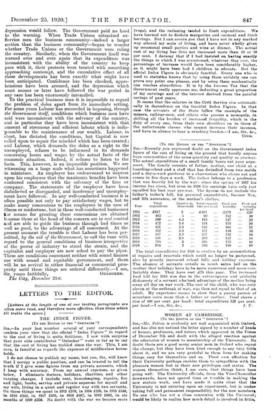[To THE EDITOR or THE "SPECTATOR. "] Sim — Recently ivou expressed
doubt on the Government index figure of the cost of living on the ground that hardly anyone buys commodities of the same quantity and quality as pre-war. The actual expenditure of a small family bears out your argu- ment. The family consists of father, mother, one child at a boarding-school and a stall that has dwindled from two maids and a day-a-week gardener to a charwoman who sleeps out and comes in five days a week. The father belongs to a profession that was heavily hit by the war : sines the spring of 1917 his income has risen, but even in 1920 his earnings have only just equalled hie best year pre-war. The figures do not include the father's tailor's bill, his personal expenditure, Income Tax, and life assurance, or the mother's clothes.
Total Number In Total expeudi- Year expenditure Household
-UM rer bead
5
£103
.2179 5
92
152 4.3
118
137 3.8
124
113 3.3
126
105 3.3
137
110 3.3
157
132 2.8
203
152
3
3
265 303
133 180
The total expenditure for 1920 is swollen by an accumulation of repairs and renewals which could no longer be postponed, also by greatly increased school bills aud holiday expenses. The absence of servants entails no much extra toil on the mother that holidays have to be more numerous and more com- fortably done. They have coat £75 this year. The inereaeod food bill for 1918 was due to tho extravagance and probably dishonesty of a servant who took advantage of the mother being away all day on war work. The cost of the child, who was only eleven at the outbreak of war, was then not equal to that of an adult. My experience seems to show that a young parson of seventeen costs more than a father nr mother. Food shows a rise of 100 per cent. per head: total expenditure 128 per cent.
1911 2517 1912 462 1913 509 1914 472 1915 421
1916 452
1917 517 1918 568 1919 795 1920 910
Food and Food and Laundry laundry pie bead ... £36
32 33 40 54 44 60


































 Previous page
Previous page